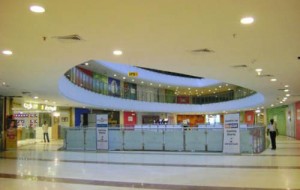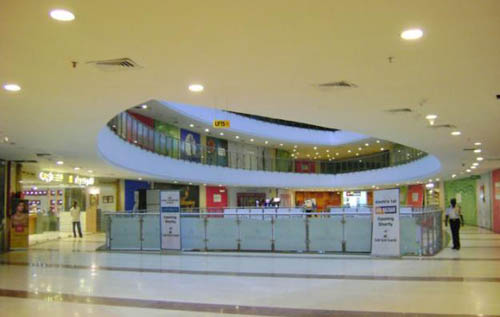 More than 30% of retail mall space against the projected supply for the first half of the year were deferred, says Cushman & Wakefield report on the retail real estate market. A fresh mall supply for H1 2012 stood at 2.27 million sq. ft. (msf). Approximately one million sq.ft. of expected mall supply was deferred to second half of the year or next year. The overall vacancy rate for the major cities as of H1 2012 stood at 19.6% marginally higher than the previous quarter.
More than 30% of retail mall space against the projected supply for the first half of the year were deferred, says Cushman & Wakefield report on the retail real estate market. A fresh mall supply for H1 2012 stood at 2.27 million sq. ft. (msf). Approximately one million sq.ft. of expected mall supply was deferred to second half of the year or next year. The overall vacancy rate for the major cities as of H1 2012 stood at 19.6% marginally higher than the previous quarter.
NCR saw the highest mall supply deferment of over 80%, ensuring the city maintained vacancy levels at 28%. NCR saw only 120,000 sq.ft of mall supply in Q1 and no supply in Q2 2012.
Bangalore witnessed the highest mall supply of 1.5 million sq. ft. (msf) in H1 2012. The retail activity in the city continues to remain strong as the new mall supply became operational with 90% occupancy, whilst overall city level mall vacancy stood at 12.6%.
Jaideep Wahi, Director, Retail Agency, Cushman & Wakefield India said, “This slowdown in mall construction need not be viewed as a negative growth indicator for the retail real estate segment. The current pace is, in fact, expected to help in maintaining a healthier supply to demand equation; especially for oversupplied micro-markets. With high vacancy levels as well as cautious expansion plans of retailers, the deferment of supply is a necessary measure to bring stability in the retail market.”
According to C&W, Rental values across most mall destinations within these cities remained largely stable, except for certain micromarkets in Bengaluru, NCR, Kolkata and Mumbai where mall rentals have seen a growth over the previous quarter in the range of 2-13%. Elgin Road in Kolkata recorded the highest growth in mall rents at 12.4% over last quarter mostly owing to renewals of existing tenants at a higher value.
In the same period, some prominent high streets across major cities recorded higher increase in rental values as against malls, reflecting the bent of interest amongst retailers for high street properties. Select locations across Bengaluru (MG Road, Jayanagar, Koramangala, Vitthal Mallya Road) recorded rental increments in the range of 8-9% over the previous quarter. Camac Street in Kolkata saw the highest increase in high street rentals at25% followed by MG Road in Bengaluru at just over 9%. Gurgaon and Pune also saw increase in high street rents by 7-8%. However, most of the prominent high streets in Hyderabad (Banjara Hills, Jubilee Hills, Ameerpeet & A.S. Rao Nagar) saw a rental fall of 4-7% compared to the previous quarter due to significant amount of new construction becoming available in these markets
Jaideep Wahi, Director, Retail Services, Cushman & Wakefield commented, “Given the current uncertain economic conditions, the retail markets are showing a largely stable scenario. Whilst high streets still remain in favour with retailers, depending on local market dynamics, demand for malls spaces is stable with retailers emphasizing on the ‘quality’ of the spaces being offered. Retailers of foreign brands still remain committed to the Indian markets with the recent announcements by multinational retailers indicating the strength of the economy.”
Though NCR’s retail market was largely subdued in the quarter, it continues to be driven by leasing activities on the high streets. However, rentals remained constant with Khan Market being the only exception as it registered a marginal increase of around 2% q-o-q. Similarly, mall rentals also remained stable with Gurgaon being the only exception to record a q-o-q increase of around 7% as a result of renewals of existing leases. On the whole, overall mall vacancy levels remained unchanged from the previous quarter at 28% with retailers maintaining a wait and watch policy as they are not ready to commit to spaces that do not meet their expectations.
Kolkata’s traditional high street locations of Camac Street and Gariahat recorded a notable q-o-q increase in rental values of 25% and nearly 7% respectively, on account of strong interest from retailers. Similarly, mall spaces in Salt Lake and Elgin Road witnessed a q-o-q increase of 2.4% and 12.6% respectively. This is largely because there is limited space available for any major transaction within the malls leading to an upward revision during lease renewals. Though some fresh mall space supply is expected by the end of the year, it may not be sufficient to meet existing demand leading to further upward movements in the rentals.
In Bengaluru, retail activity continues to remain strong with all the new mall supply becoming operational with 90% occupancy, whilst overall city level mall vacancy was estimated to be around 12.6%. Consequently, mall rentals increased by 4-7% q-o-q. across micro markets such as Bannerghatta Road, Koramangla and Magrath Road. High street retail real estate demand was seen heating up on MG Road, Jayanagar, Koramangala, Vitthal Mallya Road and Marathahalli Junction as their rentals also increased by 4-9% q-o-q. With not much supply expected until the end of the year, retailers looking for quality spaces will have to look for opportunities arising out of lease renewals and churn in both malls and high streets.
In Chennai, rental values across Malls and High Streets remained unchanged from previous quarter largely due to unavailability of quality leasable spaces resulting in a status quo. The city’s overall mall vacancy also remained stable at 8.2%. It is expected that the rentals on most high streets and in malls are likely to remain stable in the forthcoming months as a result of stable demand given the present uncertain economic conditions.
In Hyderabad, an oversupply of retail spaces in the established high streets has resulted in rentals decreasing by 4-7% q-o-q across micro markets such as Banjara Hills, Jubilee Hills, Ameerpeet and A.S. Rao Nagar. Retailers of foreign brands are interested in leasing only quality spaces, resulting in them pre committing in under construction buildings which provide better floor plate and customized specifications as per their needs. Meanwhile, retailers of domestic brands are showing an interest in spreading their operations to emerging residential micro markets such as Chandanagar and Madinaguda due to the presence of adequate supply at reasonable rentals. With fresh mall space supply expected only early next year and existing malls have a vacancy of less than 2%,mall rentals are expected to see a spike as leases in some malls come up for renewal in the next few months.
Both high street and mall rentals remained unchanged in Mumbai reflecting a stable market. Vashi was the only exceptional micro market as it witnessed a nearly 5% q-o-q rental increase in mall spaces, attributed mainly to some churn. They city will receive some sizeable fresh mall supply in Mulund and Thane beginning next year, which could then cause some change in the market dynamics for these micro markets. Overall, the markets are expected to maintain stable rentals in both the high streets as well as the malls in the next few quarters.
In Pune, while mall rentals remained stable due to sizeable vacancies (overall city average at 25%) in the recently introduced malls, the established high streets of MG Road and JM Road witnessed a q-o-q increase of around 8% due to lack of any space options. Rentals across the other high streets remained stable. Going ahead, the overall mall vacancy rate may is expected to reduce gradually as the overall economy improves with rentals remaining stable. A few established high street locations may witness some rental increases due to lack of spaces, whilst overall the high street rentals too remain stable.
In Ahmedabad, the demand-supply scenario is currently witnessing a serious mis-match as overall city level vacancy rates are quite high at around 34%. The prime reason for this is there is a shortage of ‘quality’ supply in the city. In the high streets, rentals remained stable in the face of limited demand and churn.





